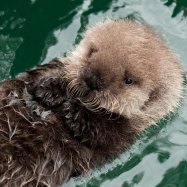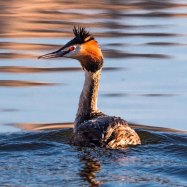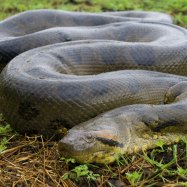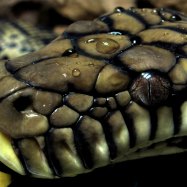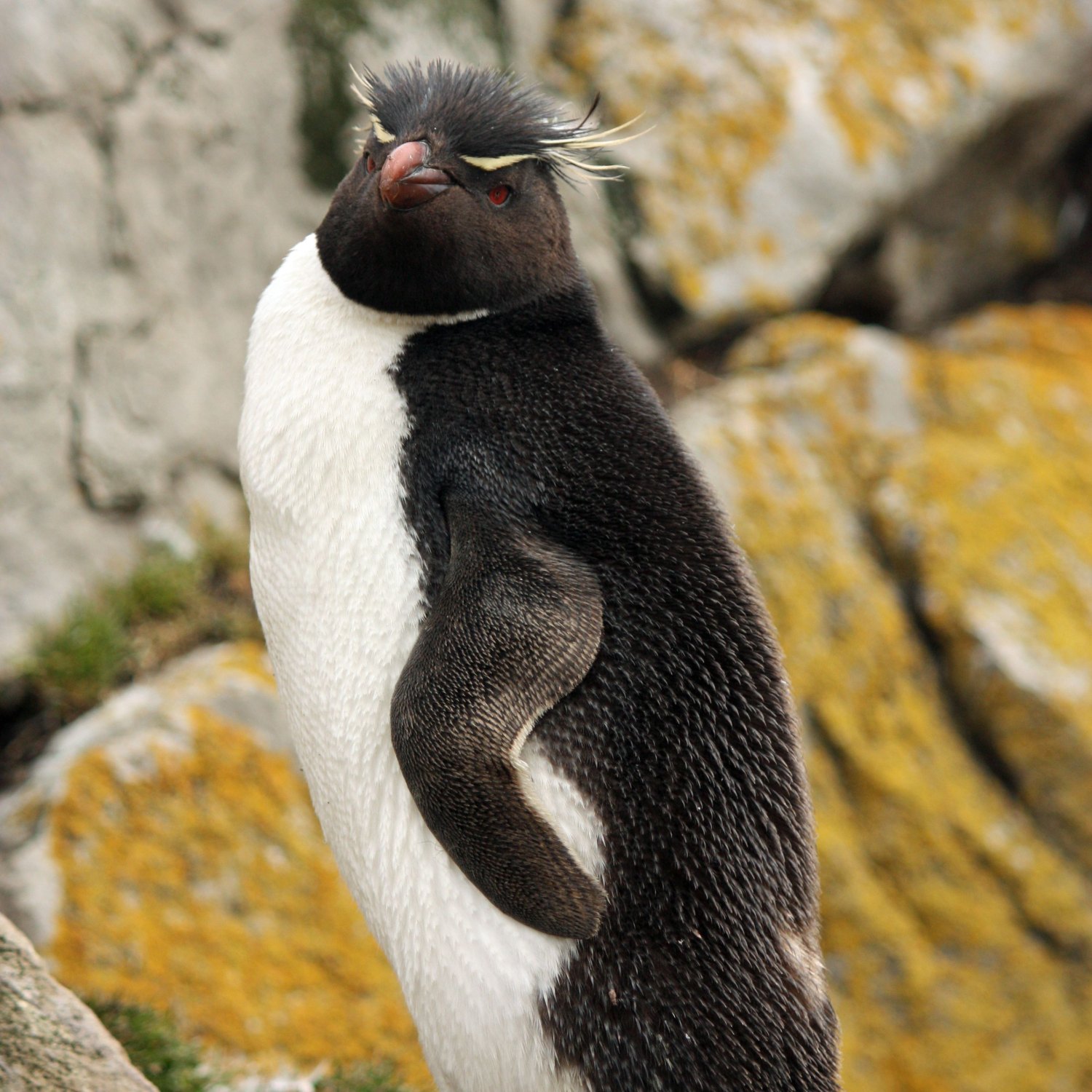
Rockhopper Penguin
20-23 inches
The Rockhopper Penguin, a species of penguin found in the Sub-Antarctic islands, stands out with its spiky yellow feathers and red eyes. These compact and streamlined birds can grow up to 20-23 inches in length, making them one of the smallest penguin species. Belonging to the family Spheniscidae, they are known for their energetic and acrobatic behaviors, making them a delight to watch in their natural habitat. #RockhopperPenguin #SubAntarcticIslands #Spheniscidae
Animal Details Summary:
Common Name: Rockhopper Penguin
Kingdom: Animalia
Habitat: Marine
The Stunning Rockhopper Penguin: A Unique Species Adapted to Life in the Southern Ocean
Have you ever wondered what it would be like to live in one of the coldest and most remote places on Earth? For the rockhopper penguin, this is their natural habitat. These spirited marine birds are not only masters of the icy waters of the Southern Ocean but also have striking features that set them apart from the rest of the penguin species. Their compact and streamlined body, striking black and white coloration, and signature "rock-hopping" behavior make them one of the most sought-after animals to observe in the wild. Let's dive into the fascinating world of the rockhopper penguins and discover what makes them truly unique Rockhopper Penguin.The Scientific Name of the Rockhopper Penguin: Eudyptes chrysocome
The rockhopper penguin, scientifically known as Eudyptes chrysocome, is a species of penguin found in the Falkland Islands and various sub-Antarctic islands. This name comes from the Greek word "Eudyptes" which means "good diver" and "chrysocome" which means "golden hair". The rockhopper penguin's signature golden crest on their head gives them their scientific name and adds to their distinct appearance.Classification of the Rockhopper Penguin
The rockhopper penguin is classified under the Kingdom Animalia, Phylum Chordata, Class Aves, Order Sphenisciformes, and Family Spheniscidae. These classifications place the rockhopper penguin in the same group as other penguin species such as the emperor penguin, Adelie penguin, and king penguin.Habitat and Distribution of the Rockhopper Penguin
As marine birds, rockhopper penguins spend most of their lives in the ocean. They are found in the Southern Ocean, which surrounds Antarctica, and can be spotted on various sub-Antarctic islands such as the Falkland Islands, New Zealand, and Tasmania. These remote islands are the perfect home for these penguins, as they provide protection from predators and abundant food sources.Carnivorous Feeding Method of the Rockhopper Penguin
Rockhopper penguins are carnivores, which means they primarily feed on other animals for sustenance Rottweiler. They have a diverse diet and will eat a variety of prey such as krill, squid, fish, and small crustaceans. These penguins are known for their efficient diving abilities, which allows them to hunt for prey in the depths of the ocean.The Stunning Look of the Rockhopper Penguin
One cannot help but be mesmerized by the striking appearance of the rockhopper penguin. They have a distinctive black and white coloration, with a bright yellow-orange crest on their head. Their eyes are surrounded by a pink-orange patch, giving them a unique and charming appearance.Adaptations of the Rockhopper Penguin
Living in the harsh environment of the Southern Ocean requires specific adaptations for survival. The rockhopper penguin has evolved to have a compact and streamlined body shape, which is perfect for diving and swimming in the ocean. They also have a layer of blubber under their skin to keep them warm in the freezing temperatures.Another unique adaptation of the rockhopper penguin is their "rock-hopping" behavior. These penguins have strong legs and webbed feet that allow them to jump from rock to rock with ease, making it easier for them to navigate the rugged and rocky terrain of their habitat.
Size and Weight of the Rockhopper Penguin
The rockhopper penguin is a small penguin species, with an average length of 20-23 inches and a weight of 5-6.5 pounds. Despite their small size, they are incredibly resilient and can withstand extreme temperatures and harsh weather conditions.Conservation Status of the Rockhopper Penguin
The rockhopper penguin is currently classified as vulnerable on the IUCN Red List, with a declining population trend. Although they are not hunted by humans, they face threats from climate change, oil spills, and overfishing, which depletes their food sources. Conservation efforts are being made to protect the rockhopper penguin and their habitat, such as establishing marine protected areas and monitoring their population size.Observing Rockhopper Penguins in the Wild
If you ever have the opportunity to observe the rockhopper penguin in the wild, you are in for a treat. These charismatic creatures are known for their playful and curious behavior, making them a joy to watch. Their active nature and distinctive appearance make them a favorite among wildlife photographers and adventurers.In Conclusion
The rockhopper penguin is a remarkable species that has adapted to thrive in the harsh and isolated environment of the Southern Ocean. From their striking appearance to their unique behaviors, there is no doubt that these penguins are truly extraordinary. As the threats to their population continue to rise, it is crucial to raise awareness about their conservation and appreciate their beauty. Let us all continue to protect and admire the remarkable rockhopper penguin.

Rockhopper Penguin
Animal Details Rockhopper Penguin - Scientific Name: Eudyptes chrysocome
- Category: Animals R
- Scientific Name: Eudyptes chrysocome
- Common Name: Rockhopper Penguin
- Kingdom: Animalia
- Phylum: Chordata
- Class: Aves
- Order: Sphenisciformes
- Family: Spheniscidae
- Habitat: Marine
- Feeding Method: Carnivorous
- Geographical Distribution: Southern ocean
- Country of Origin: Falkland Islands
- Location: Sub-Antarctic islands
- Animal Coloration: Black and white
- Body Shape: Compact and streamlined
- Length: 20-23 inches
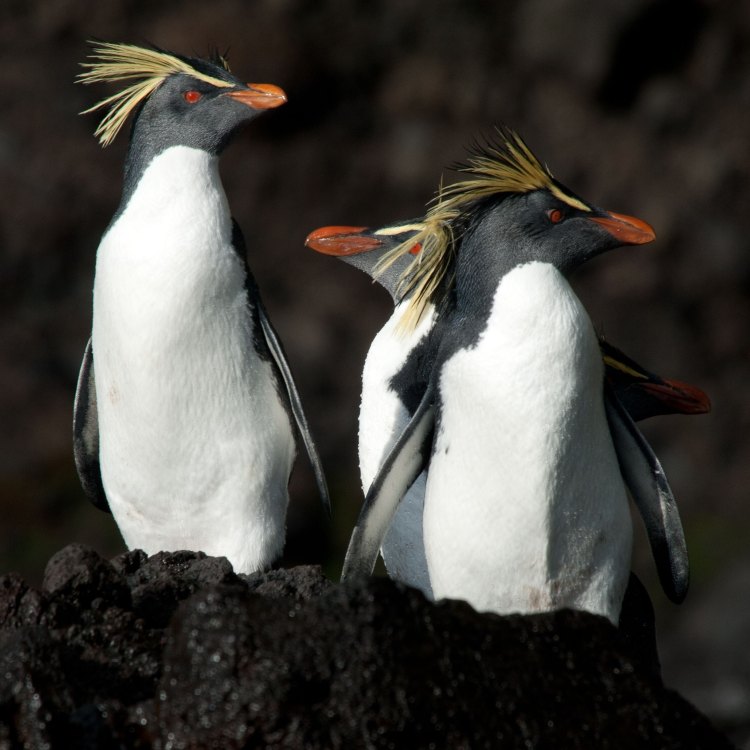
Rockhopper Penguin
- Adult Size: Medium-sized
- Average Lifespan: 10-15 years
- Reproduction: Monogamous
- Reproductive Behavior: Nest in colonies
- Sound or Call: Loud screech
- Migration Pattern: Migratory
- Social Groups: Colonial
- Behavior: Energetic and agile
- Threats: Climate change, overfishing, oil spills
- Conservation Status: Vulnerable
- Impact on Ecosystem: Important part of the marine food chain
- Human Use: Tourism, research
- Distinctive Features: Yellow and black spiky eyebrows, red eyes
- Interesting Facts: Known for their distinctive appearance and impressive jumping ability
- Predator: Marine mammals, birds, and humans
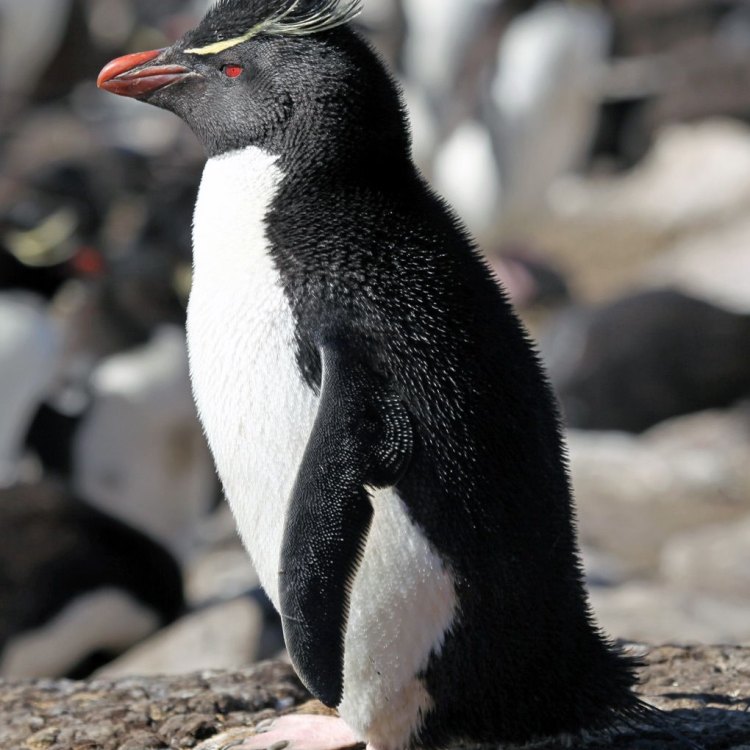
Eudyptes chrysocome
The Rockhopper Penguin: An Iconic and Threatened Species
The rockhopper penguin is a medium-sized penguin species native to the sub-Antarctic regions of the world. These charismatic birds belong to the Spheniscidae family and are closely related to other penguin species such as the king, gentoo, and chinstrap penguins. What makes these birds unique and captivating is not only their distinctive appearance but also their energetic behavior and important role in the marine ecosystem. In this article, we will delve into the fascinating world of rockhopper penguins and explore their life, behavior, threats, and conservation status PeaceOfAnimals.Com.Life of a Rockhopper Penguin
Rockhopper penguins are characterized by their small stature, standing at only 20 inches tall and weighing around 5.5 to 7 pounds. They have black and white feathers on their back and belly, with a distinctive yellow and black spiky eyebrow that gives them a comical expression. Their red eyes further add to their striking appearance. These penguins are sexually dimorphic, with males being slightly larger than females.On average, rockhopper penguins have a lifespan of 10 to 15 years in the wild. However, some individuals have been known to live up to 20 years. They reach sexual maturity at around 2 to 3 years of age and typically breed every year.
Reproduction and Reproductive Behavior
Rockhopper penguins are monogamous, meaning they have only one partner throughout their breeding season and sometimes even for life Rough Earth Snake. They form breeding colonies on rocky outcrops and cliffs along the coast, with some colonies comprising thousands of penguin pairs. These colonies provide protection from predators and help keep the penguins warm in the cold and harsh sub-Antarctic climate.The breeding season for rockhopper penguins begins in late September to early October. During this time, the male penguins start to build nests using rocks and twigs, which they carefully arrange to ensure the eggs do not roll away. The female then lays two eggs, with the second one being smaller and weaker than the first. Incubation lasts for about 33 days, with both parents taking turns to keep the eggs warm.
Sounds and Migration Pattern
Rockhopper penguins are known for their loud and distinctive screech, which they use to communicate with their mates and neighbors. This loud call can be heard from miles away and helps keep the penguins in touch with each other in the crowded breeding colonies.Unlike other penguin species that remain in the same location year-round, rockhopper penguins are migratory birds. They spend the breeding season on their breeding grounds and then travel hundreds of miles to their wintering grounds in search of food. This migration is essential for their survival as it allows them to access more abundant food sources.
Social Groups and Behavior
Rockhopper penguins are social birds and live in large colonies with other penguins. They exhibit interesting social behavior, including head shaking, bowing, and vocalizations, to communicate with each other.These penguins are also known for their energetic and agile behavior, both on land and in water. They are avid swimmers, reaching speeds of up to 20 miles per hour in the water, and use their flippers to jump in and out of the water, a behavior known as "porpoising." They are also skilled climbers, using their sharp claws to grip the rocky cliffs and scale steep slopes.
Threats to the Rockhopper Penguins
Despite being agile and skilled hunters, rockhopper penguins face numerous threats in their environment, which have caused a decline in their population. The main threats include climate change, overfishing, and oil spills.Due to climate change, the sub-Antarctic regions are experiencing melting sea ice, ocean acidification, and changes in ocean currents. These changes impact the availability of food for rockhopper penguins, as they primarily feed on krill and small fish. The decreased availability of food sources can lead to malnutrition and reproductive failure.
Moreover, overfishing of krill and other fish species affects the prey availability for rockhopper penguins, making it challenging for them to find enough food to sustain themselves and their young.
Oil spills are another significant threat to these penguins. As they spend most of their time in the ocean, they are vulnerable to oil spills, which can coat their feathers, affecting their ability to regulate their body temperature and causing hypothermia. Oil spills can also contaminate their food source, leading to illness and even death.
Conservation Status and Importance in the Ecosystem
Due to these threats and their declining population, rockhopper penguins are categorized as "vulnerable" on the IUCN Red List. Their numbers have declined by a staggering 90% in the past three generations, and if significant conservation efforts are not made, they could face extinction in the near future.Rockhopper penguins play a vital role in the marine ecosystem as they are part of the marine food chain. They are mid-level predators, feeding on krill and small fish, and are preyed upon by various marine mammals such as leopard seals and killer whales, as well as birds and humans. Despite their small size, these penguins are crucial to maintaining a healthy and balanced ecosystem.
Human Use and Research
Rockhopper penguins have been the subject of extensive research studies, primarily due to their unique behavior and the threats they face. Researchers study their diet, breeding patterns, and migration patterns to better understand these penguins and their role in the ecosystem. This research is crucial in developing effective conservation strategies to protect these vulnerable birds.Moreover, these penguins also have significant economic importance, particularly in the tourism industry. Many people travel to sub-Antarctic regions to see these charismatic birds in their natural habitat, contributing to the local economy. Responsible and sustainable tourism can help raise awareness about the threats faced by these penguins and generate funds for conservation efforts.
Predators of the Rockhopper Penguins
Lastly, it is important to mention the predators of rockhopper penguins. In addition to marine predators such as leopard seals and killer whales, these penguins also face threats from birds such as skuas and gulls. However, the most significant threat to these penguins comes from human activities, including overfishing, pollution, and climate change.In Conclusion
In conclusion, the rockhopper penguin is a unique and fascinating species that is facing numerous threats to its survival. These charismatic birds, with their distinctive appearance and energetic behavior, play a vital role in the marine ecosystem and are important for research and tourism, making efforts towards their conservation crucial. It is our responsibility to ensure that these iconic birds continue to thrive in their natural habitat for future generations to admire and appreciate.
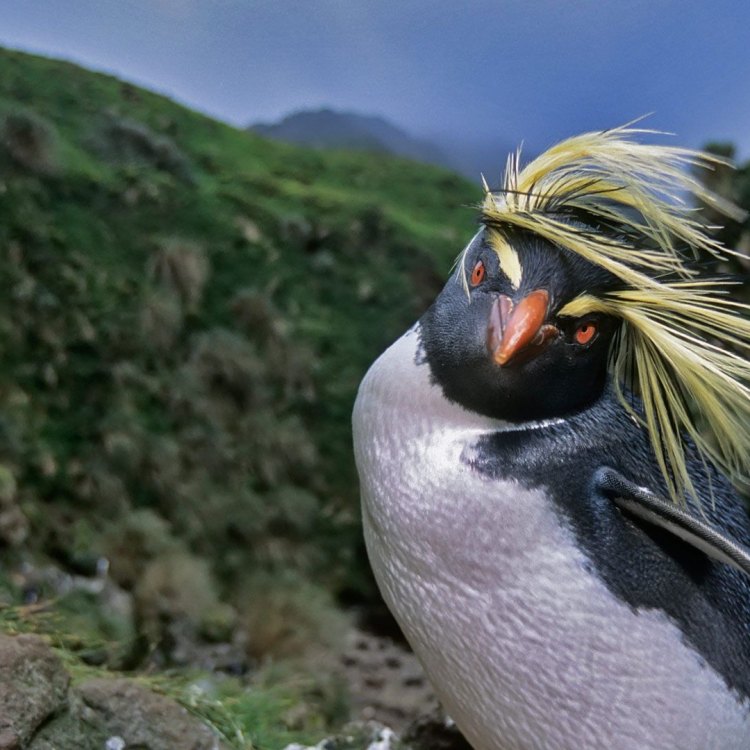
The Stunning Rockhopper Penguin: A Unique Species Adapted to Life in the Southern Ocean
Disclaimer: The content provided is for informational purposes only. We cannot guarantee the accuracy of the information on this page 100%. All information provided here may change without prior notice.


